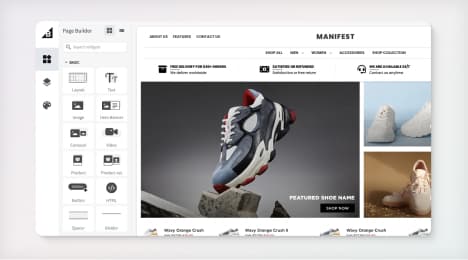
Watch Our Product Tour
See how BigCommerce helps you build and manage your online store with ease.
- Ecommerce Insights

6 Key Steps to Launch Your Online Store
Explore our Launch Foundations series to get your BigCommerce store up and running quickly.
BigCommerce helps growing businesses, enterprise brands, and everything in-between sell more online.
What is Unified Commerce?
Between the revenue impact of negative shopping experiences and the potential uplift of positive shopping experiences, there is a $3.3 trillion global opportunity for merchants who embrace Unified Commerce.
$3.3 trillion. Got your attention? Good. Because Unified Commerce is undoubtedly attention-worthy. It’s an exciting technology solution presenting enormous opportunities for merchants across every industry, be it retail, online, entertainment, or hospitality. From more seamless interactions to agile global expansions, merchants who embrace Unified Commerce today will be cheering tomorrow.
But what exactly is Unified Commerce, and how can it help your business?
Omnichannel vs Unified Commerce
Let’s put the most common question to bed first: What's the difference between unified commerce and omnichannel shopping?
Unified commerce is not just another buzzword for omnichannel shopping. While the two solutions are inextricably linked, they are markedly different setups with the potential for very different results. Where an omnichannel approach tends to stop after multichannel expansion and frontend alignment, unified commerce consolidates all your channels, payment systems, products, and customer interactions to deliver a totally integrated, measurable, and frictionless experience.
That’s not to say omnichannel isn’t relevant anymore. In fact, if you’re already delivering omnichannel services, you’re heading in the right direction. But you may be missing out on a wealth of cross-channel insights that are only available to truly unified commerce businesses.
Unified Commerce: Defined
Unified commerce is the practice of connecting your backend systems with your customer-facing channels via a single platform. It’s the setup companies require in order to support omnichannel journeys and create a unified view of shopper interactions, products, and management systems.
Via one centralized platform, unified commerce gives you a more complete view of your business that allows you to capture consolidated data insights. With these insights, you can serve your customers better and adapt your business as you need. Unified commerce helps you track your performance across channels and regions so you can make more informed business decisions, and better prepare for future change. In fact, according to Adyen’s 2020 Retail Report, 50% of unified commerce retailers saw transactions remain consistent during the COVID-19 pandemic, while 40% more was spent by in-store shoppers when they moved online.
Sell from one platform
Payments play a key role in the implementation and success of unified commerce. By consolidating all your payment systems and data across every channel, whether it’s in-store, online, or in-app, you can better identify your customers, understand their needs, and facilitate seamless cross-channel experiences.
Linking your online and offline sales channels increases loyalty and drives higher spend. Unified commerce shoppers spend higher amounts and more often.
Customers don’t tend to think about separate channels when they shop. Ecommerce, mobile, and point of sale payments are simply interrelated parts of a whole that form the overall experience of your brand. So it makes sense that you should sell, refund or exchange in a way that mirrors your customers’ thinking and puts their preferences at the center of every interaction.
Selling from one platform allows you to:
Process payments and refunds globally through one contract, on one platform.
Eliminate the need to manage local acquiring region to region.
Use one back-end system to manage all payments from any channel and region, with consolidated reporting.
Keep reconciliation simple and reduce the workload of your reporting and finance teams.
Facilitate recurring payments with real time account updates.
By centralizing your payments, it’s easy to support seamless customer journeys, regardless of region or channel. In this way, you’re not only enhancing customer experiences, but you’re setting yourself up for greater agility and scalability.
There are four key components through which unified commerce can achieve this.
The four components of Unified Commerce
1. Systems.
Because unified commerce integrates all customer-facing and backend systems via a centralized platform, your entire operation is built on one solid foundation that can adapt and scale as your business needs. This reduces the time and resources spent managing multiple providers, improves operational efficiencies, and makes it possible to capture consolidated data insights across multiple touchpoints.
This makes it far easier to enter new markets, expand to new channels, and integrate emerging technologies, like mobile wallets or endless aisles, that help you scale your business, regardless of channel or region.
2. Channels.
By unifying payments from every channel into a single platform, it’s easier to securely identify and link shoppers across channels and regions, helping you better fulfill cross-channel purchases, such as endless aisle or click and collect options. You can also easily measure your results: analyse how opening a store affects your ecommerce sales in the same area, or see how an in-app loyalty program affects in-store purchases.
Consider, for example, buy online and return in store services. A customer buys an item online and goes to return it in-store due to a fault, only to be told by staff that they have no record of the online purchase, nor any information on the item’s warranty. The customer will feel frustrated and be less inclined to shop with that brand in the future.
3. Products.
Customers should get a consistent view of products across stores and online channels. Store staff should have just as much knowledge of stock availability as warehouse staff do. And if your app says there are size 12 polka dot pants in-store, your staff should be able to confirm that information to a polka dot loving customer over the phone with just one click on an inventory management tool, and even help facilitate the sale right then and there.
From shopping online and collecting in-store to buying in-store and choosing home delivery, unified commerce opens up a wider range of delivery options to your customer. Consider endless aisle options, which can serve up your entire inventory to shoppers via in-store kiosks or tablets, help put an end to out-of-stock issues, and even increase sales by up to 14%.
4. Interactions.
Customers expect speed, convenience, consistency and personalization in their interactions with brands. Unified commerce ensures that customer interactions are securely captured and centralized, so you can easily recognize shoppers across multiple touch points, build a deeper understanding of their behavior, and serve them better for it. For example, a customer won’t have to re-enter payment details every time they shop, and can check out in one click from whichever channel they like.
Laying the groundwork for global growth
Unified commerce represents an exciting opportunity to streamline global growth and serve your customers better. So where to from here? We recommend you run an audit of your business’ existing platforms and processes, and identify how many systems are currently outdated or siloed.
Take your time to do your research, identify your key challenges, and choose the right technology partner to provide expert guidance. With the right foundation, achieving your business goals will be surprisingly simple.
Keen to kick off your Unified Commerce journey soon?****Find out how Adyen can help you get started.
BigCommerce helps growing businesses, enterprise brands, and everything in-between sell more online.
Start growing your ecommerce business even faster.
High-volume or established business? Request a demo